June 13: The good news – our basement didn’t flood again last night. We had some major down pouring, but the ground must have un-saturated enough over the last few days to give our old concrete basement walls a chance to hold back the flood. We had a nice week – a great picnic with Kathy and Alivia and Rayna at our local park, playtime with Jessica and Eli and Celia, and today we’re going to see Pam and Clara. Pictures from the last several days (including some baby-in-the-bath pics) are in the gallery.
Good times
June 11: We had a lovely day yesterday! After many days of rain, I was ready for a sunshiny day. The weekend and Monday were a little rough sleep-wise. Sylvie kinda stopped napping during the day, and she decided to wake up every hour and a half or two hours at night. On Monday, I felt really fuzzy and groggy and unable to finish thoughts or be particularly coherent. Tuesday, though, we went with Kathy, Alivia, and Rayna to our neighborhood park where we played and picnicked for over five hours. I had no idea so much time had gone by. THEN, both children slept at the same time for nearly two hours. This really hasn’t happened before. 45 minutes, 20 minutes…possible. But an hour! Two! Oh, bliss. I let Sylvie sleep on my lap for the first hour. These days I don’t let her do that much because I don’t want her to need to sleep on my lap, but I really wanted her to sleep. Then for the second hour of her long nap (the longest in days), I was not doing anything for either child. It was amazing.
Last night, I was home alone in the evening and both kids went down smoothly. Sylvia didn’t nurse from 8pm until 3:30 am. I slept from 11pm until 3:30 straight. Oh delicious REM sleep. It does so much for a person’s mental health. Over four hours of continuous sleep was just what the doctor ordered. In fact, when she got up again at 4:30, I couldn’t fall asleep afterwards because I felt so very rested. I wanted to get things done!
Today we’re planning to hang out with Jessica, Eli, and Ceila. The weather seems promising again. Should be a fun, fun day!
Andrew is currently negotiating with me to go “All by myself to JabaCat.” (really Java Cat).
I said, “What if someone sees you riding alone to JabaCat and says, ‘Little boy, where is your mother?'”
Andrew said, “I would tell them, ‘She’s at home!.”
He’s now saying, “I’m getting ready…I’m ready to go. I can put on my shoes all by myself.”
I think I may need to intervene here.
Wedding photos for your printing pleasure
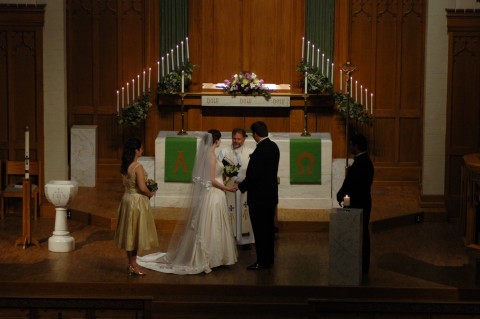 May 8: We recently received the digital version of the photos for Maretta and Kyle’s wedding. I’ve uploaded the pictures to Walgreens.com, and you are welcome to log on there and print out any pictures you’d like. What lovely memories I have from that day!
May 8: We recently received the digital version of the photos for Maretta and Kyle’s wedding. I’ve uploaded the pictures to Walgreens.com, and you are welcome to log on there and print out any pictures you’d like. What lovely memories I have from that day!
Early June days
May 8: It’s been a good week. Pictures are in the gallery. We’re having some major rain events the last couple days. And Sylvia has been on an anti-nap jag, which is not OK. But in general, things are good.
I’ve been having fun reading a blog I enjoy, Pioneer Woman. She’s written up a thirty-some chapter recounting of the story of how she met and married her cowboy husband. As she says, “Green Acres meets Harlequin Romance in my crazy, rip-roarin’ real-life tale of true love.” It’s been quite entertaining.
Last weekend Sylvia and I attended Becky’s high school graduation ceremony. The little one didn’t like the cheers or the cymbals crashing one bit, but in general she did a great job.
Last week we had a lovely evening at Lake Wingra next to Michael’s Frozen Custard. Andrew loved climbing all over the playground, and we all enjoyed a picnic, ice cream, frisbee and teatherball, and a walk down to the lake. Terry’s mom, Topsy, is visiting from Oregon, so we’re having fun seeing her.
On Thursday, Andrew, Sylvie, and I drove out to Jack’s house for a little overnight trip. We met Terry, Tom, Topsy, and Terry’s Aunt Rusty who is visiting from Minnesota. Andrew took me on an adventurous walk toward the woods as we hunted for a bear. The brambles turned us back, and we ended up trying to find purple treasure flowers (a.k.a. spiderwort) instead. That little kid has an amazing imagination. Andrew had a good time playing with Tom and getting read to by Topsy and Rusty.
Today, our friends Jessica and Mitch came over for lunch, and then we watched Eli and Celia while their parents went to look at a house around the corner that they are considering.
As I type, Sylvie is sitting next to me grinning and sucking on her hands. Andrew is raptly watching Monsters Inc. for the first time.
A nice, rainy Sunday evening treat.
Bryan’s first software ships
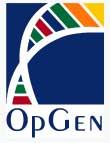 June 5: Bryan’s been working extra-hard the last several weeks as he has been completing the first release of the software that he has been designing. He started at OpGen last September, and he’s really been enjoying it. You can see his blog post about completing the software here. He also wrote three posts describing what his company does on his blog, which I have posted below.
June 5: Bryan’s been working extra-hard the last several weeks as he has been completing the first release of the software that he has been designing. He started at OpGen last September, and he’s really been enjoying it. You can see his blog post about completing the software here. He also wrote three posts describing what his company does on his blog, which I have posted below.
Here comes the science, Part 1
I’ve been wanting for some time to make a post or two to try and explain the basics of the science that is the core of our company. The techniques described here are in the public domain so there’s nothing secret here. I’ve been working here long enough that I now feel pretty confident that I understand the process at a fairly high level.. just the right amount to be able to describe it to someone else that might find it interesting. For part 1 here, I will just describe the basic premise and will cover more actual detail in later posts. I’ve really enjoyed learning this stuff and I hope that other people find it interesting too.
The “Op” stands for Optical
The company’s name, OpGen, is based on the fact that the core scientific process behind the business is called “optical mapping” which is, in short, a technique for taking physical samples of DNA and creating a visual representation of it such that unique organisms can be easily differentiated from each other and similarities between other organisms can be easily spotted. The whole concept is that you can break up DNA into many fragments and then put those fragments together in a line and you get what we call a “map”. What’s useful about this is that similar organisms will consistently and repeatedly break up in the same way such that their maps are very similar. As you’ll see later, these maps almost look like barcodes and you can actually think of them as such, or as a “fingerprint” which uniquely identifies an organism. Here’s an example of what one might look like:
What’s it for?
The most interesting applications for optical mapping that I am aware of are in the area of what we call “comparative genomics” (other people might call it something else). Basically, it’s the practice of looking at a number of similar or related organisms and analyzing what’s different about them. For instance, say you have maps of two isolates of the same species of bacteria that cause infections in humans.
Furthermore, say that one of those isolates is known to be extremely nasty and hard to treat, while the other is easily killed off with a round of antibiotics. By comparing the maps of these two bugs, you can actually see where the two are genetically different. Those parts that are different most likely indicate where the nastiness of the bacteria is regulated and can point the way for researchers to know where to look when trying to figure out how to combat that strain.
Coming soon…
In future posts I’ll tell you more detail about how we actually create those maps and talk about the software I’m working on and how it pertains to these maps.
Here comes the science, Part 2
This time around I’m going to dive down into a little more detail about what actually goes on in the process of making this optical maps of DNA samples. At a theoretical level, the process is fairly straight forward and sounds pretty basic. However, as I’m learning while working here, real life does not think very highly of our nice, simple, straight-forward theories. So the process has to be very robust, especially on the software side, which makes me very glad that I work with a lot of really smart people.
Making DNA lay down straight
The whole linchpin of this process is being able to measure the length of the strands of DNA (more accurately, the lengths of DNA fragments but we’ll get to that shortly). In order for length to have any meaning, we need to have the subjects we’re measuring be as close to a straight line as possible. In order to do that we use a glass surface (you remember those microscope slides you used in high school) and a cover slip that has microscopically small channels carved into it. The DNA is placed, in solution, onto this surface and, using a magical process I know nothing about, the DNA is stretched out along those channels which serve as guides for straightening out the molecules.
Cutting it up into fragments
In order to create meaningful maps that can be used to identify and compare organisms we need to break up the DNA molecules into fragments.
It’s these fragments that we measure to create that nice-looking barcode map. In order to create those maps you use what is called a “restriction enzyme”, which are enzymes that actually cut DNA. A particular restriction enzyme always cuts in the same place, at a particular occurrence of base pairs in the DNA strand. For example, the enzyme BamHI cuts at restriction sites of GGATCC. As an aside, most restriction enzymes cut at sites that are palindromic.. there’s no obvious reason that I know of why that is, but it sure is a neat coincidence. Due to the genetic makeup of different organisms, different enzymes will cut different numbers of fragments for each organism. Part of our process is picking an enzyme that will cut the “right number” of fragments, that is, enough to make a meaningful map.
Too few fragments or too many fragments often make the maps indistinguishable from each other.
Measuring those fragments
As part of the preparation of the DNA, a stain is applied that will cause the fragments to light up or “fluoresce” when exposed to a laser. The glass slip containing the DNA solution is placed on a fluorescent microscope that has a camera attached to it and an automated software system moves the camera up and down the length of those channels and takes pictures through the microscope. Here’s an example of what it looks like. Remember this is one tiny fraction of a single image from the microscope. You can see several broken strands of DNA. The colored one is one that has been picked out by the software as clean enough to be measured and recorded.
Hundreds of such images are acquired and finally fed through some image processing software that finds the nicest looking DNA molecules and it finds the fragments and measures their length in some unit of measure that is smaller than anything I can image. Finally those fragment lengths are recorded in order and they can be visually represented by that barcode-like display I showed last time. Here’s an artists interpretation of how that looks:
Assembling the pieces
Here’s where the real world comes in and whacks you in the head. DNA will almost never stay fully in tact throughout the process I just described. And even if it did, there are usually a lot of molecules and they tend to overlap each other or they don’t straighten out exactly right (or sometimes at all). So what you end up with is lots and lots of small maps that represent just a chunk of the entire strand of DNA.
And here is where some intense computing power is brought to bear on the problem as we take all of those smaller maps and try and determine how and where the overlap each other. It’s kind of analogous to trying to put a piece of paper back together after it has been through a shredder. When this process is finally done (and everything worked out okay) you end up with a “consensus map”, which is the amalgamation of
all of those smaller map chunks.
Once you’ve got that consensus map, then the doors open to a wide range of things you can do with it and that’s where the software that I’m working on comes into play. But I’ll save that stuff for the third and final installment of this series. Thanks for reading!
Here comes the science, Part 3
Before I went on hiatus it was just about time to talk about the software that I’ve been working on and how it pertains to the process of working with optical genome maps and actually doing something interesting with them.
Building a database
As I mentioned in previous posts the most interesting thing you can do with an optical map is to compare it to other maps of similar genomes for the purposes of looking at similarities and differences. But in order to do that you need a repository of maps and way of categorizing and searching that repository to find what you’re looking for. We didn’t have anything like that at the time I started so it was the first thing I worked on and we now have a nicely categorized, searchable database of over 40,000 genome maps.
Making maps in software
Creating optical maps is currently a time-consuming process and we’d need a lot of people to make 40,000 maps by hand. The vast majority of those maps that we have in the database are what are called “in-silico” maps, which is a cutesy way of saying that they were made in software. When you think about what mapping is, you’re taking little bits and pieces of DNA and cutting it up with an enzyme and then measuring the fragments that get created. We don’t necessarily know what the actual DNA sequence of that genome is and it’s actually irrelevant for the purposes of creating optical maps (which can be very helpful, which I’ll describe later). However there are plenty of people out there who are working hard at sequencing the genomes of all sorts of organisms.
We can take those sequences (the literal nucleotide sequence, e.g. ATCGGACT) and simulate the process of applying a restriction enzyme to cut that sequence into fragments to create in-silico maps. Luckily someone out there already wrote libraries for doing these sorts of things so it was pretty easy to use that code to populate our database.
Comparing maps
Really the critical functionality of the software I’m working on is the ability to compare maps to each other. In a nutshell we compare maps by looking at the series of fragments in each map and use some complicated math that I’ll likely never understand to figure out whether or not they’re “close enough” to each other to confidently say that they probably represent the same underlying DNA structure. While it’s very likely that the actual DNA sequences are different in some respects, those differences are small enough that they don’t show up at the map level. And we can reasonably assume that these are regions of similarity between the genomes. Using maps these similarities and differences are very easy to visualize.. here’s an example of a couple of similar strains of P.aeruginosa:
The purple parts are regions of similarity while the white parts represent regions that do not appear to be similar at all. It’s immediately obvious where these particular strains differ and where they appear to have common structure.
Extracting meaning
All of these leads up to my final point which is how you can use this software for comparing maps to extract meaning. As we know, the DNA structure of organisms dictates what they look like and what they are capable of in the physical world. In our particular realm we’re mainly looking at bacteria.. specifically bacteria that make people sick.
There are a lot of species of bacteria that make people sick and, within those species, there are several sub-species or strains that act differently. Some are particularly nasty, some are immune to certain antibiotic medications, and some are just run-of-the-mill . Since these strains are all of the same species they (frequently, but not always) end up sharing a lot of similar DNA. So by comparing maps of the different strains you can fairly easily see places where the DNA structure differs and that can really help you isolate the region of the genome that is cause a particular strain to be especially nasty.
I guess that’s about it for now .. this is getting pretty long. I may revisit this topic a little later as more code gets written and I start in on more new things. Right now I’m kind of in the middle of a round of bug-fixing and polish and that’ s just not that interesting!! Bye for now.
A really wonderful day
May 31: On Friday, my co-worker, Vicki, and her son Alex came over to our house, and we had a wonderful time. Sylvia took a couple of very long morning naps, and then when she woke, she was so happy. Sleep begets sleep, and she also went down for a nice early afternoon nap. Andrew and Alex had a blast playing together. They colored and ran around the yard and practiced using the potty. I had gotten enough sleep the night before, and I just felt really good. We all made blueberry muffins, and Vicki and I got to visit for four hours…delightful.
It’s so fun to watch Andrew and Alex play together. Compared to where they were a year ago, they’re such big boys! Pictures of the last few days are in the gallery.
Special instructions for people like me
May 29: I’m trying to make a fruit terrine that was featured in Wondertime magazine as I strained the jarred pineapple juice into the already strained mandarin orange juice in a saucepan, I read in the recipe, “drain the grapefruit juice into a pan.”
Grapefruit, pineapple. They’re both compound worded fruits. Too bad that pineapple contains an enzyme that prevents it from turning into a gelatin.
The funny part, was upon realizing my mistake, I started scanning the recipe, hoping to find something that said something along the lines of:
“If you accidentally purchased pineapple instead of grapefruit, don’t fear! Pat yourself on the back for attempting a new recipe, finding the jarred pineapple in the first place, and even for just navigating the grocery store with two kids! Instead of the terrine, try making the fruit salad identified below.”
No such alternative instructions were to be found. Either they ran out of space on the page or they presumed that most people would actually purchase the ingredients identified. Hmmm. Now I’m two hours from dinner and both dinners I have planned have to marinate for 6-12 hours. This may or may not be the best planning.
🙂
Is this what normal feels like?
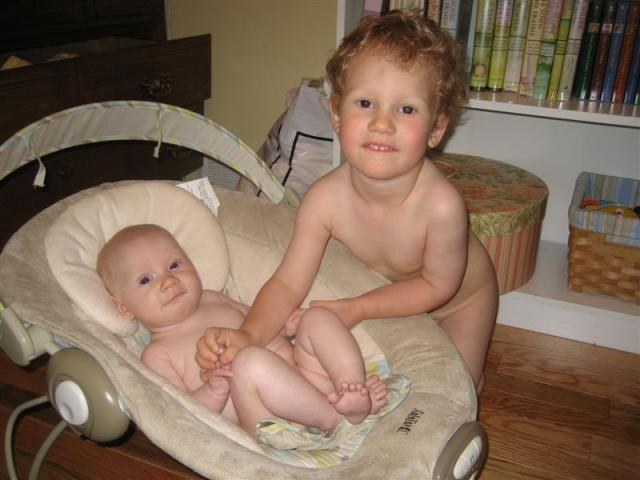 May 27: Andrew is napping this afternoon. Sylvie woke up just as I was putting him down, and she is now rather happily perched on my lap as I type. It’s nice to be able to type and kiss bald baby head at the same time. I’m sitting here in the relative quiet and feeling a sense of a new existence. Like I’m at the ocean’s edge, and the tide all went out and I’m seeing that the starfish-filled tide pools are a very different landscape from the waves that were present a few hours ago. Life post-wedding; life with two kids; life not going to work at Gathering Waters; life being a full-time mom (with no immediate wedding planning) in the summer.
May 27: Andrew is napping this afternoon. Sylvie woke up just as I was putting him down, and she is now rather happily perched on my lap as I type. It’s nice to be able to type and kiss bald baby head at the same time. I’m sitting here in the relative quiet and feeling a sense of a new existence. Like I’m at the ocean’s edge, and the tide all went out and I’m seeing that the starfish-filled tide pools are a very different landscape from the waves that were present a few hours ago. Life post-wedding; life with two kids; life not going to work at Gathering Waters; life being a full-time mom (with no immediate wedding planning) in the summer.
Yesterday (Memorial Day) I really unwound. Bryan was Mr. Accomplishing, mulching garden beds, cleaning the gutters, staining planks of wood to make a picnic bench. Me? I read a Barbara Kingsolver book and sorted through bags of 6-12 month clothes, pulled out 0-3 month clothes that are too small, and in general re-organized Sylvie’s dresser and closet. I should mention again that I LOVE baby clothes. I love touching them and folding them and creating new outfits. And I love putting them on my little ones. I think I decided to dive into clothes because it most certainly did not need to be done. And I wanted to do something that I didn’t need to do. The last couple weeks have been quite full of prioritized lists, so it felt good to pick an off-the-list task. Plus, I now have new things to put on my sweet princess pottywottykins.
My co-worker Pam goes back to work today. Her daughter Mercy is a week younger than Sylvie, and so her first day back at work makes me quite aware that I am not going back to work. I’ve got to say, though, that while I miss seeing my co-workers and thinking critically and having conversations that don’t involve kids and doing work that I really think makes Wisconsin a better place, I don’t really miss my job. It’s summer, and I get to be outdoors with the kids and have Andrew give me big hugs and say things like, “I’ll love you forever, Mommy.”
Last night I wrote up a list of meals to make for the week, and this morning the kiddos and I went to Woodman’s. They are remarkably good shoppers, and Andrew is even tending to leave the house cheerfully (AMAZING). Sylvie is happy in the front carrier, and we happily shopped together, purchasing over $200 worth of food. Good heavens, I must be crazy. On the other hand, I’m making lots of meals that will have leftovers, and I’m not eating out much for lunch any more. Because I am slightly compulsive and type-A, I made a Woodman’s shopping list laid out like the store is to try to streamline the shopping process. Feel free to copy and use yourself if you’d like. These are the kinds of things I do when I don’t have a job:) Oh, and my dad made a very similar list when I was a kid, so I come by it genetically.
Heather and Michael and Evelyn were in town for Maretta’s wedding, so I got to see them all, if only quite briefly. I’m going out to DC in August for Kacy’s wedding, and I’m hoping to spend significantly more time with them then. Evie is soooo cute and tiny. Just one month old:)
My stream of consciousness is faltering, and Sylvie would like me to interact with her now. The muffled explosions emanating from her nether regions may need to be dealt with on the changing table as well. Have a happy summer!
Fist set of pictures from the photographer
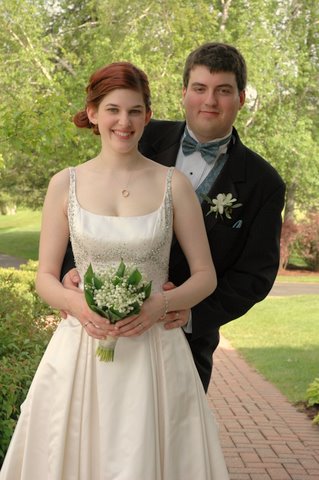 May 25: We’ve gotten to see quite a bit of the bride and groom today. This morning, we met at Terry’s and watched as they opened up their wedding gifts. I have a sort of post-race euphoria going on. Seeing everyone so content and glowing is a real treat.
May 25: We’ve gotten to see quite a bit of the bride and groom today. This morning, we met at Terry’s and watched as they opened up their wedding gifts. I have a sort of post-race euphoria going on. Seeing everyone so content and glowing is a real treat.
This afternoon, our little clan went to a local park to attend my friend Sarah’s birthday party. We brought several of the table boquets from the wedding reception, and it was fun to get to share their prettiness with more people.
Maretta and Kyle stopped by our house a few minutes ago. They spent some time getting things from Dad’s house and then went to visit Michael and Joe. They’re being quite generous with their newly-wed selves:) Tomorrow they head up to St. Paul to spend a week honeymooning in their own new apartment.
Late last night our photographer, Dick Baker, sent me a big, early set of photos from the wedding. Thanks Dick! You can find them in the gallery.
My sister is married!
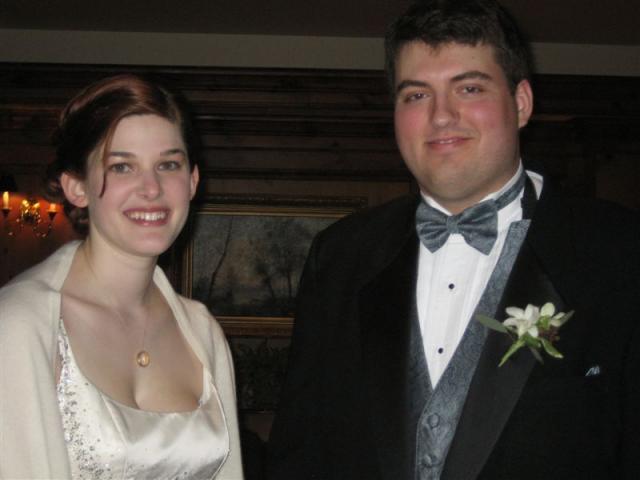 May 24: I’ve got a new brother:) Maretta and Kyle were married today, and everything was simply beautiful. We’ll be getting photos from the photographer in a week, but for now I’ve uploaded around 50 pics I took from the day. I also posted pictures from the past couple days of getting readiness.
May 24: I’ve got a new brother:) Maretta and Kyle were married today, and everything was simply beautiful. We’ll be getting photos from the photographer in a week, but for now I’ve uploaded around 50 pics I took from the day. I also posted pictures from the past couple days of getting readiness.
From start to finish, the day was just lovely. The day dawned sunny. All the lilac bushes are in bloom, and it seemed like warmth and bird songs and spring color were filling the world.
Maretta, Laurie (her maid of honor), Marilyn (Kyle’s mom), Pam (Kyle’s sister), and I met at nine this morning to get our hair made all pretty. I stopped by the reception site (Nakoma Country Club) to check on things, and it all looked just beautiful. So many pretty flowers, silver and white, and green-bedecked tables. We all had a fun time getting ready together, and then the ceremony began at 12:30.
Terry and I walked Maretta down the first half of the aisle and then Dad walked her down the rest of the way to Kyle. I’ve uploaded the wedding program for your reading pleasure. The hymn “For the beauty of the earth” really kind of did me in. It was a beautiful ceremony. Kyle cried, they both laughed; at one point, Maretta gave a two thumbs up to the congregation. They sounded so true and monumental saying their vows, and they both looked so young and happy and fresh and in love. I couldn’t have wished them a more beautiful ceremony.
The reception was a luncheon buffet, starting out with some mingling and nibblings and greetings. It was a lot of fun to meet many of Kyle’s relatives, and with the stunning daylight streaming in the windows, we all ate and drank and laughed and enjoyed that post-wedding happy feeling.
Sylvie traveled around the room…I think I only held her when she needed to eat, and I barely heard a peep out of her all day. She was a jolly, dimply smiling girl. Andrew fell asleep on the car ride to the reception, so he spent the first part of the reception angelicly sleeping on a sofa. Then he had fun munching on the yummy food and playing with his aunts and uncles.
We sent the couple off with a cloud of bubbles, and they then went on a carriage ride for an hour.
Our clan headed over to Terry’s after the reception, and the bride and groom stopped by after their carriage ride to say hello. What a lovely day. I am so bushed! It went so well. Most importantly, Maretta and Kyle are now hitched, and they can begin their lives together. What an amazing thing.
